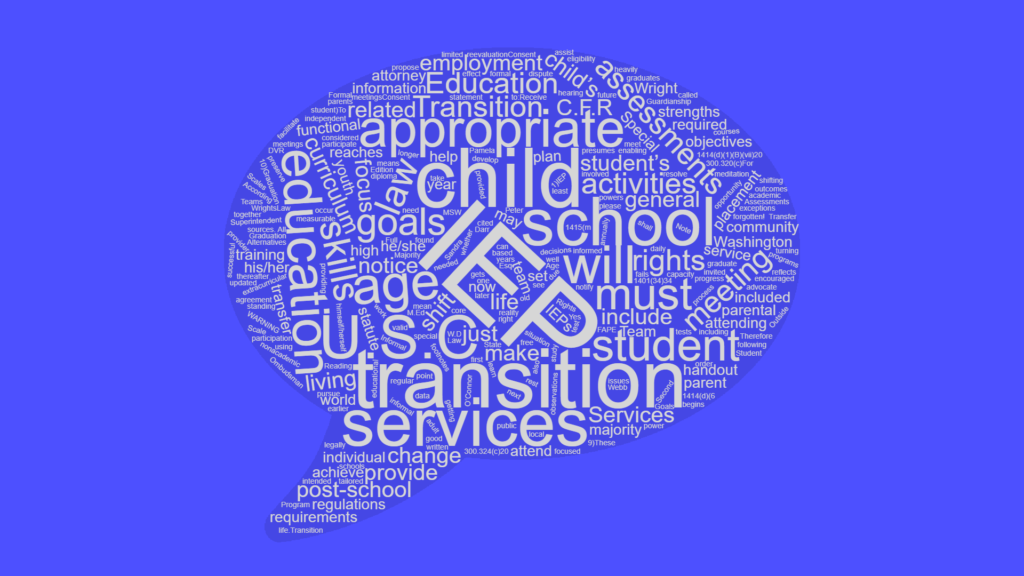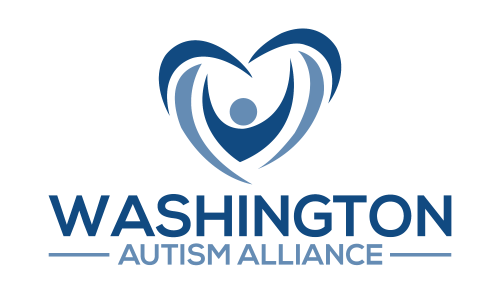Secondary transition services are intended to help youth with disabilities make the transition from the world of high school to the world of adulthood. Individualized Education Program (IEP) Teams work together to plan and implement academic and non-academic courses and programs of study that help all youth achieve successful post-school outcomes such as postsecondary education and training, employment, and community engagement.
This is a turning point in your student’s life. The focus is shifting from just getting through the next year to the future after school. The law specifies requirements for transition services that are different than the law and requirements before transition that reflects this shift in focus.

Transition Services
Timing: At the LATEST transitional planning should be included in the first IEP to be in effect when the child is 16, and updated annually thereafter. This is just when the school will be required to change the focus of the IEP. The shift to transition can occur earlier if the parents and school are in agreement. (1)
IEP Team: Your Student! (2) Yes, your student is now required to at least be provided notice of the IEP meeting and invited to attend. There are exceptions to the student attending the IEP meeting, but it is heavily encouraged that the student begins attending the IEP meetings. The IEP meeting is a good opportunity for your student to learn self-advocacy skills that he/she will be using the rest of his/her life.
Transition Assessments: According to the law, Transition Services need to be tailored to the individual student’s strengths and goals. In order to achieve this, schools will (should) provide both formal and informal Transition assessments. Informal assessments include observations in the classroom, conversations with the student, and functional skills inventory. Formal assessments are standardized tests that have data showing that they are reliable and valid such as a Wechsler Full Scale IQ or a Vineland Adaptive Behavior Scales test.
Outside service providers (such as DVR) may also be called in to evaluate and assist in Transition services. Note: if an outside service provider fails to provide the transition services described in the IEP, the local educational agency shall reconvene the IEP Team to identify alternative strategies to meet the transition objectives for the child set out in the IEP. (3)
Transition Services: Transition Services are defined in both the statute (4) and the regulations (5). At its core, transition services are a coordinated set of activities for a child with a disability that is designed to facilitate a child’s movement from school to post-school activities. The IEP team must take into consideration the child’s strengths, preferences, and interests when deciding which services are necessary and appropriate to meeting the goals for life after school.
Transition services includes but is not limited to instruction, related services, community experiences, the development of employment and other post-school adult living objectives, and, when appropriate, acquisition of daily living skills and functional vocational evaluation.
IEP Goals: Before the age of 15 or 16, your student’s IEP probably focused on “participation in appropriate activities,” (6) enabling “the child to be involved in and make progress in the general education curriculum,” and to “participate in extracurricular and other nonacademic activities.” (7) When your child gets to be age 15 or 16 the focus of the IEP will shift from the general education curriculum to life after school and what skills will be needed then. The IEP team must develop appropriate measurable transition goals for the transition plan. These goals are included in your child’s IEPs. The goals must be based on “age appropriate transition assessments related to training, education, employment, and, where appropriate, independent living skills.” (8) This does NOT mean that the general education curriculum should just be forgotten!
Transfer of Rights at Age of Majority: The age of majority in Washington State is 18 years old. At this age the law of Washington presumes that each individual now has the capacity to make decisions for himself/herself, whether or not that is the reality of the situation. The school must provide you and your child with notice that your parental rights will transfer to your child when he/she reaches the age of 18. No later than one year before your child reaches the age of majority, the IEP must include a statement that the child was informed that rights will transfer. (9)
These rights include the right to:
- Receive notice of and attend IEP meetings
- Consent to a reevaluation
- Consent to a change in placement (including graduation)
- Request meditation or a due process hearing to resolve a dispute about issues related to providing a free appropriate public education (FAPE) (this means that as the parent, you would no longer have standing to legally advocate for your student)
To preserve parental rights under the law, a parent may pursue guardianship or a power of attorney over their student. (10)
Graduation: Graduation is considered a change in placement! Therefore, the school must notify you before they propose to graduate your child. WARNING: once your child graduates from high school with a regular diploma, his/her eligibility for special education services ends.
Recommended Reading: I found the information for this handout from the statute and regulations cited in the footnotes as well as the following sources.
- All about IEPs and Special Education Law, Second Edition, written by Peter W.D. Wright, Esq.; Pamela Darr Wright, MA ,MSW; and Sandra Webb O’Connor, M.Ed. from WrightsLaw. http://www.wrightslaw.com/
- Washington Education Ombudsman: http://www.governor.wa.gov/oeo/
Office of the Superintendent of Special Education: https://www.k12.wa.us/SpecialEd/programreview/Monitoring/SecondaryTransition.aspx
Author: Katherine J. Hurt, J.D.
- 20 U.S.C. §1414(d)(1)(A)(i)(VIII)
- 20 U.S.C. §1414(d)(1)(B)(vii)
- 20 U.S.C. §1414(d)(6); 34 C.F.R. §300.324(c)
- 20 U.S.C. §1401(34)
- 34 C.F.R. §300.43
- 20 U.S.C. §1414(d)(1)(A)(i)(I)
- 20 U.S.C. §1414(d)(1)(A)(i)(IV)
- 20 U.S.C. §1414(d)(1)(A)(i)(VIII)(aa)
- 20 U.S.C. §1415(m); 34 C.F.R. §300.320(c)
- For more information on guardianship and powers of attorney, please see the “Guardianship & the Alternatives” handout.


